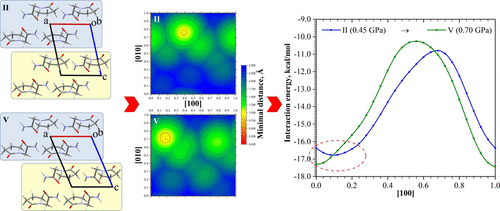当前位置:
X-MOL 学术
›
Cryst. Growth Des.
›
论文详情
Our official English website, www.x-mol.net, welcomes your
feedback! (Note: you will need to create a separate account there.)
High-Pressure Influence on Piracetam Crystals: Studying by Quantum Chemical Methods
Crystal Growth & Design ( IF 3.2 ) Pub Date : 2021-09-13 , DOI: 10.1021/acs.cgd.1c00534 Yevhenii Vaksler 1, 2, 3 , Abdenacer Idrissi 1 , Svitlana V. Shishkina 2, 3
Crystal Growth & Design ( IF 3.2 ) Pub Date : 2021-09-13 , DOI: 10.1021/acs.cgd.1c00534 Yevhenii Vaksler 1, 2, 3 , Abdenacer Idrissi 1 , Svitlana V. Shishkina 2, 3
Affiliation

|
The method developed previously for studying mechanical properties using quantum chemical calculations was applied to predict the most probable direction of deformation of the piracetam polymorphic Form II under pressure. By the analysis of the pairwise interaction energies between molecules in Form II, this structure was classified as columnar-layered. The shear deformation modeling of the strongly bound fragments in crystal packing predicted the [100] crystallographic direction with a shift energy barrier of 5.2 kcal/mol to be the most probable within the (001) crystallographic plane for Form II deformation. Comparison of Form II before the polymorphic transition and Form V after the crystal structure change confirmed the results of quantum chemical modeling. The analysis of the shift energy profile indicated the characteristic features (a local minimum near the starting point, negative interaction energies between layers during the displacement, and a low shift energy barrier) that can be used to predict a polymorphic transition. The study of the pairwise interaction energies in the piracetam Forms II and V under pressure has revealed that the crystal structure can be changed under pressure in two stages. In the first stage, the polymorphic transition occurs due to the shift of weakly bound layers without changing the columnar-layered type of the crystal structure from the energetic viewpoint. In the second stage, a change in the ratio of the interaction energies between BSM1 and BSM2 results in the transition of the crystal structure type from columnar-layered to columnar without changing the polymorphic form.
中文翻译:

高压对拉西坦晶体的影响:用量子化学方法研究
之前开发的用于使用量子化学计算研究机械性能的方法被应用于预测拉西坦多晶型II在压力下的最可能变形方向。通过分析II型分子间的成对相互作用能,将该结构归类为柱状层状结构。晶体堆积中强结合碎片的剪切变形模型预测 [100] 结晶方向与 5.2 kcal/mol 的位移能垒最有可能在 (001) 晶面内进行II 型变形。形态比较II的多晶型转变及表前V晶体结构变化后证实了量子化学模型的结果。位移能量分布的分析表明了可用于预测多晶型转变的特征特征(起始点附近的局部最小值、位移期间层之间的负相互作用能以及低位移能垒)。吡拉西坦晶型 II和V 中成对相互作用能的研究在压力下揭示了晶体结构可以在压力下分两个阶段发生变化。在第一阶段,从能量的角度来看,由于弱结合层的移动而不改变晶体结构的柱状层状类型而发生多晶型转变。在第二阶段,BSM 1和BSM 2之间相互作用能比的变化导致晶体结构类型从柱状层状转变为柱状,而不改变多晶型。
更新日期:2021-10-06
中文翻译:

高压对拉西坦晶体的影响:用量子化学方法研究
之前开发的用于使用量子化学计算研究机械性能的方法被应用于预测拉西坦多晶型II在压力下的最可能变形方向。通过分析II型分子间的成对相互作用能,将该结构归类为柱状层状结构。晶体堆积中强结合碎片的剪切变形模型预测 [100] 结晶方向与 5.2 kcal/mol 的位移能垒最有可能在 (001) 晶面内进行II 型变形。形态比较II的多晶型转变及表前V晶体结构变化后证实了量子化学模型的结果。位移能量分布的分析表明了可用于预测多晶型转变的特征特征(起始点附近的局部最小值、位移期间层之间的负相互作用能以及低位移能垒)。吡拉西坦晶型 II和V 中成对相互作用能的研究在压力下揭示了晶体结构可以在压力下分两个阶段发生变化。在第一阶段,从能量的角度来看,由于弱结合层的移动而不改变晶体结构的柱状层状类型而发生多晶型转变。在第二阶段,BSM 1和BSM 2之间相互作用能比的变化导致晶体结构类型从柱状层状转变为柱状,而不改变多晶型。











































 京公网安备 11010802027423号
京公网安备 11010802027423号